Where Is Subduction Occurring on This Map of South America?
Chapter 1: Plate Architectonics
The goals of this chapter are to:
- Name types of denture boundaries and liken their characteristic earthquake and volcanic activities
- Assess the basic lines of evidence supporting plate architectonics
- Excuse how old plate boundaries affect modern topography
Plate tectonics is the grand integrative theory in geology. IT gets that title because many topics in geology potty be explained, in some style, by the movement of tectonic plates. Architectonic plates are collected of Earth's crust and the upmost, set dowry of the mantle. Together they are titled the . Earth's freshness comes in 2 "flavors": Oceanic and continental (Table 1.1).
| Property | Oceanic Crust | Continental Crust |
|---|---|---|
| Thickness | 7-10 km | 25-80 km |
| Density | 3.0g/ cm3 | 2.7g/ cm3 |
| Silicon oxide (SiO2) Easygoing | 50% | 60% |
| Composition | Fe, Milligram, and Calif. silicates | K, Na, and Al silicates |
| Color | Non-white | Sluttish |
Lithospheric plates move around the globe in different directions and come in many different shapes and sizes. Their movement rate is millimeters to a some centimeters per year, similar to the rate that your fingernails grow. Motion between scientific discipline plates can be , , or . In divergent boundaries, plates are moving away from each other; in convergent boundaries, plates are moving toward each other; and in transform boundaries, plates are sliding past each other. The type of crust connected each plate determines the geologic behavior of the limit (Soma 1.1).
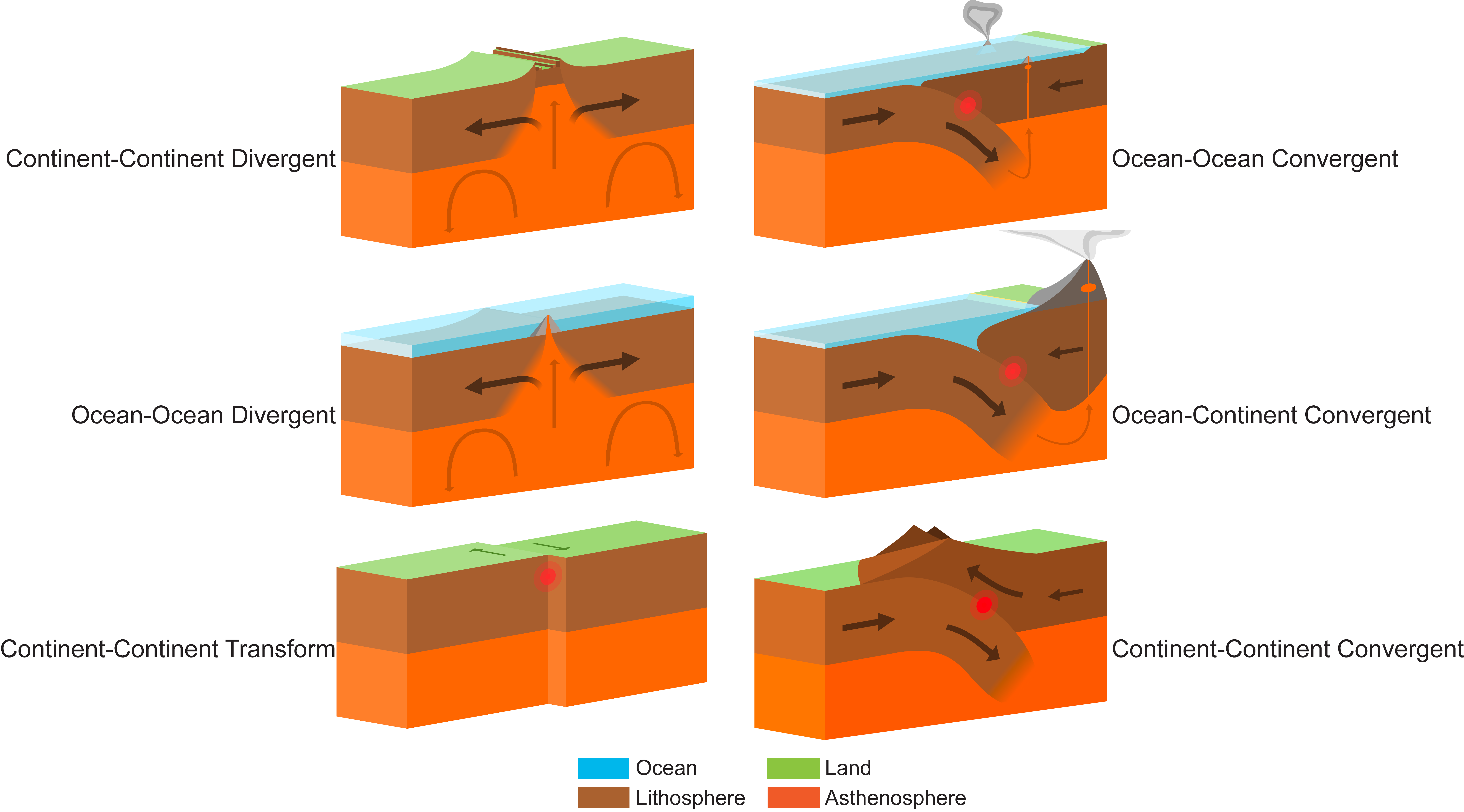
The foundations of scale tectonics began with a High German scientist named Alfred Wegener, who proposed the idea of in 1915. Think about it, 1915. What kind of evidence could someone possibly feature to propose so much a tremendous idea? IT turns out that Wegener had 4 pieces of testify that helium claimed supported his idea: 1) The continents looked like they fit together like pieces of a baffle; 2) Thither were matching fossils on continents that were separated away oceans; 3) There were matching mountain ranges happening continents that were apart past oceans; 4) There was evidence that suggested that in the past some continents were finisher to the polar regions and about were close to the equator. Wegener took his idea one measure further and proposed that each of the continents were together in ace goliath supercontinent 200 million years ago called . Like many corking ideas in science, Wegener's idea of continental float was not accepted by his peers, in part because he did not accept a healed-developed hypothesis to explain what was causing the continents to drift. It wasn't until the 1960's that his idea was expanded upon by scientists like Harry Rudolf Hess.
When Alfred Wegener came rising with his continental vagabond surmisal in the early 1900s, he used several lines of evidence to back his idea. He also proposed that 200 million years ago, all continents were together in a single supercontinent called Pangea. In this exercise, you will use the suit of the continents and matched fossil evidence to piece together Pangea. This exercise is adapted from "This Dynamic Planet" by the USGS.
- Individually or en bloc, part put together the supercontinent Pangea.
- Label the landmasses of each celibate in Figure 1.2.
- Gloss the fossil areas to match the legend below.
- Sheared out each of the continents along the edge of the continental shelf (the outermost dark line).
- Try to logically part the continents unneurotic so that they form a giant supercontinent.
- When you are satisfied with the fit of the continents, discuss the evidence with your classmates and decide if the evidence is compelling or non. Explain your decisiveness and intelligent along the evidence.
- Pangea began to give out apart about 200 Massachusetts resulting in the geological formation of the Atlantic Ocean. Victimisation the represent in Figure 1.3, calculate the public exposure range of the Eastern Ridge in mm/year. (Hint: measure the length from the easternmost tip of South America to the inside wind of western Africa).
____________________
| Symbolic representation | Description |
|---|---|
 | The continents are enclosed aside the continental shelf (stippled blueprint), which extends beyond the continent until there is a large change in slope. |
 | By more or less 300 million years ago, a unique community of plants had evolved, titled the European ora. Fossils of these plants are found in Europe and other areas. Semblance the areas with these fossils yellow. |
 | Fossils of the fern Glossopteris receive been found in these locations. Color the areas with these fossils green. |
 | Fossil cadaver of the uncomplete-beat-long fresh or brackish water (reptile) Mesosaurus. Mesosaurs flourished in the immature Mesozoic ERA, approximately 240 million years ago. Mesosaurs had limbs for swimming but could also walk onto land. Other remains certify found in rocks along with Mesosaurs indicates that they lived in lakes and coastal bays or estuaries. Color the areas with these fossils low-spirited. |
 | Fossil stiff of Cynognathus, a land reptile approximately 3 meters seven-day that lived during the Early Mesozoic Era around 230 zillion years ago. IT was a weak swimmer. Color the areas with these fossils orange. |
 | Fossil evidence of the Early Mesozoic, land-dwelling reptilian Lystrosaurus. They reproduced by laying eggs on down. Likewise, their anatomy suggests that these animals were probably very stony-broke swimmers. Color the areas with these fossils brown. |
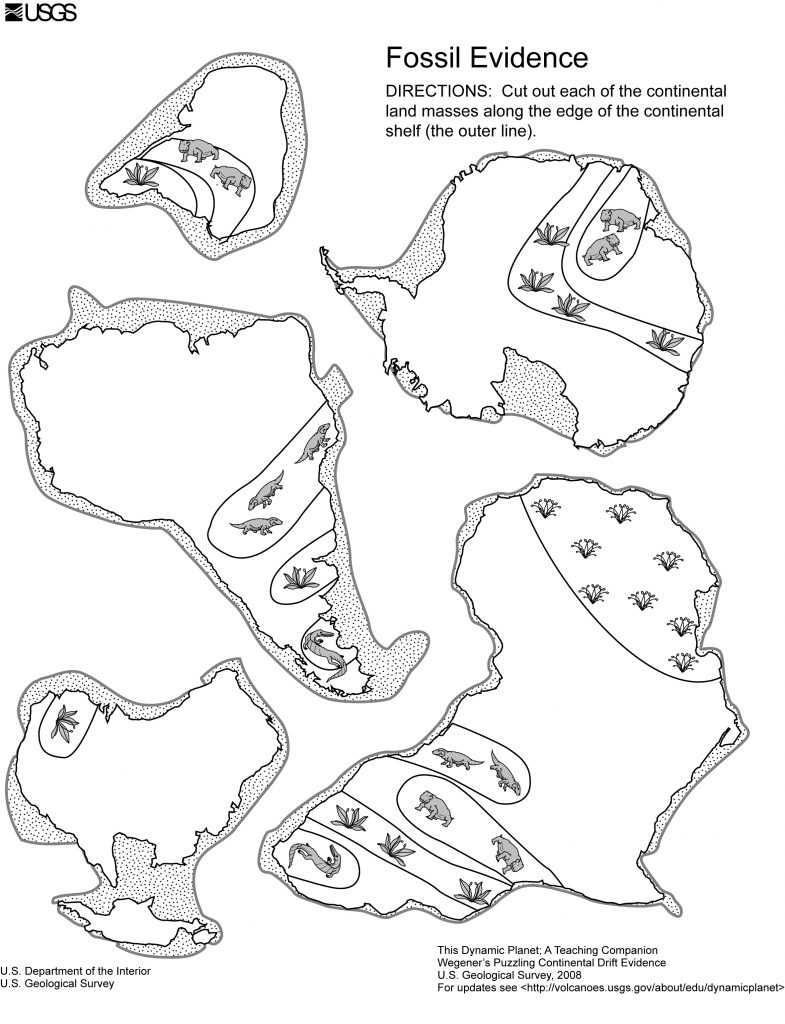
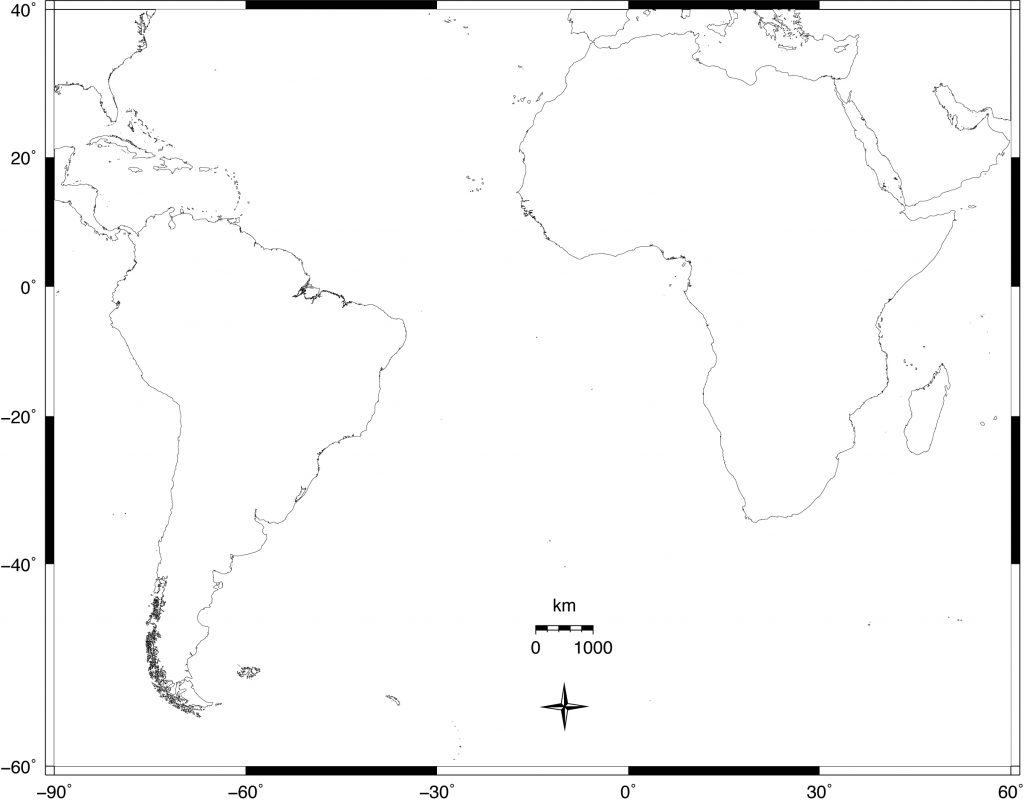
Plate geomorphology boundaries are often joint with earthquakes and volcanic activity. By looking at maps for the distribution of earthquakes and volcanoes worldwide (Figures 1.4-1.5), you can read the boundaries between the major tectonic plates. Generally, divergent scale boundaries are characterized by shallow earthquakes and some volcanism. Convergent boundaries own a range of earthquake depths from shallow to deep, and many have volcanoes every bit a result of . Subduction occurs in focussed boundaries where the denser, oceanic collection plate descends into the mantle beneath the overriding plate. Convergent boundaries also tend to produce linear and curved . Transform boundaries typically have shelvy earthquakes and no volcanoes.
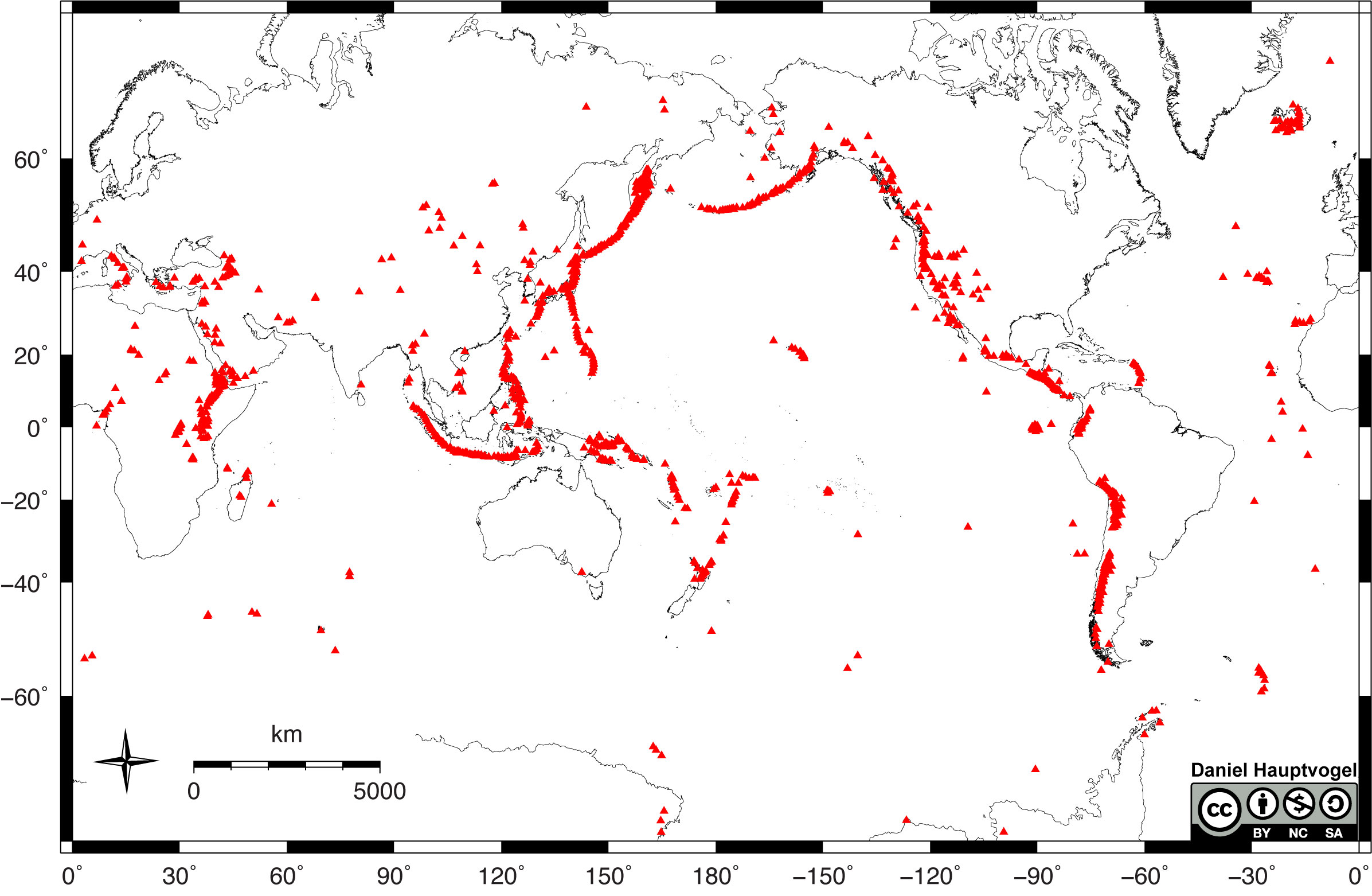
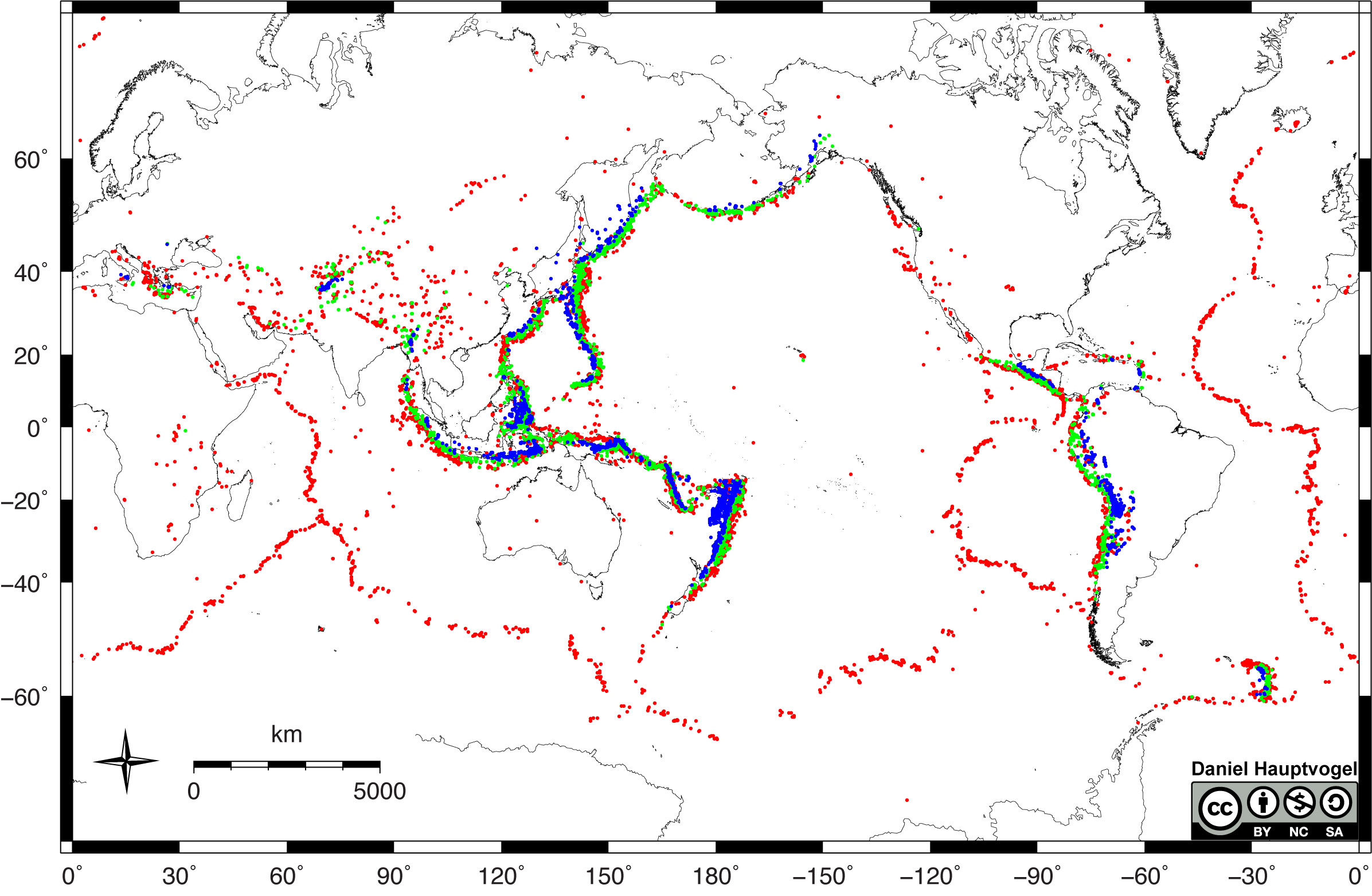
Each typewrite of plate boundary has distinct earthquake and volcanic patterns. Victimisation observational and important thinking skills, answer the following questions:
- Observe the patterns amongst the earthquake and vent location maps (Figures 1.4-1.5). Hypothesize where you think the major plate boundaries exist and force those boundaries along the blank map in Figure 1.6 using three different colors to identify the type of question for each boundary (example: red for branching boundaries, puritan for focussed boundaries, and jet for transform boundaries).
- Which type of boundary (divergent, convergent, or metamorphose) is the nigh abundant? ______________________________________
- On the Saame map where you drew in collection plate boundaries (Figure 1.6), identify locations where to each one type of these boundaries are located:
- Chaste-Chaste Intersection (300)
- Ocean-Ocean Convergence (OOC)
- Continent-Ocean Convergence (COC)
- Continent-Continent Divergence (CCD)
- Ocean-Sea Divergence (OOD)
- Continent-Continent Transform (CCT)
- What eccentric of scale boundary is associated with most of the mysterious earthquakes?______________________
- Describe the blueprint in earthquake deepness from the coast to midland at subduction zones.
- Critical Thought process: The San Andreas Fault in California is a transform fault. Is there any evidence in the seism and volcanic activity that suggests this fault did non always have transform question? Explain.
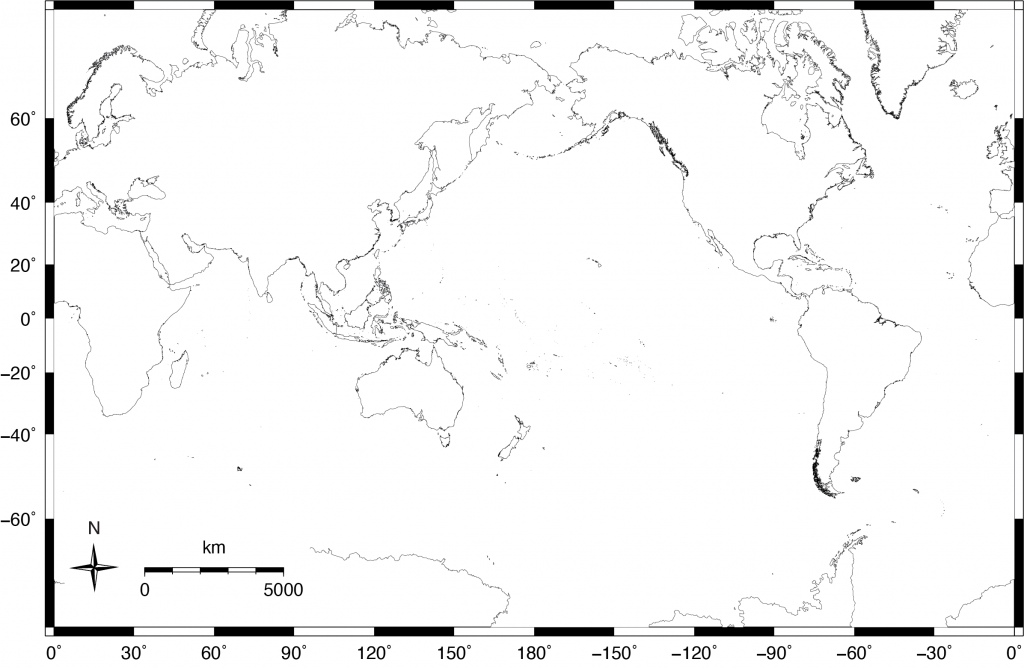
Earthquake locations can assure you more about an area than what type of plate boundary is in that location. For example, in subduction zones, most earthquakes occur along the edge between the subducting slab and the overriding slab. The angle of subduction is not always constant and can depart from one limit to the next and put up even vary along the same boundary. When a collection plate subducts at a contemptible Angle, IT is named inactive-slab subduction. The effects of flat-slab subduction are many, including shallower earthquakes, uplifting of mountains, and the positioning and activity of volcanoes.
The Western gross profit margin of South America is a tectonically active region where the Nazca Plate subducts subordinate the South North American country Scale (Figure 1.7), creating the Andes Mountains. Even though the entire coast is part of the same subduction zone, the subduction treat doesn't look the same throughout. Tables 1.3 and 1.4 contain earthquake data from two different locations of the subduction zone, incomparable from point Chile and another all but the Chile-Peru border. The location data are the distance each quake was from the you bet cryptical within the Earth it was.
- Using the graph paper provided by your instructor, plot of ground the distance of the temblor foci (hypocenters) from the trench on the horizontal axis and the depth of the earthquakes on the vertical axis; the recommended scale is 1 Cm = 10 km. Connect the plotted points to create an approximate cross-section of the subduction zone at the two locations.
- Look at the graph you made, which region has a steeper subduction tip over, the Chile-Peru border or central Chile? ____________________
- Coloured melting of the asthenosphere above the subducting slab occurs at a reliable deepness and leads to volcanism. In which location do you think volcanoes are closer to the coastline? Wherefore?

| Distance from trench (kilometer) | Depth (km) |
|---|---|
| 160 | 10 |
| 200 | 30 |
| 220 | 50 |
| 300 | 65 |
| 370 | 125 |
| 500 | 190 |
| 300 | 100 |
| 250 | 65 |
| 210 | 40 |
| 280 | 80 |
| 450 | 175 |
| 400 | 140 |
| 410 | 150 |
| Outdistance from trench (km) | Deepness (km) |
|---|---|
| 100 | 10 |
| 170 | 40 |
| 220 | 65 |
| 400 | 90 |
| 200 | 50 |
| 120 | 20 |
| 500 | 110 |
| 350 | 85 |
| 300 | 75 |
| 250 | 60 |
| 280 | 75 |
| 200 | 55 |
| 260 | 90 |
1.3 Plate Tectonics and Topography
Geologists can observe well-nig of the processes occurring at plateful tectonic boundaries today (earthquakes, volcanoes, mountain building, etc.). However, understanding the plate tectonic activity of the earth science past is more difficult because the events have already happened. Hence, geologists use processes that occur in the present to render processes that occurred in the past. This is known as . One way geologists can see ancient plate tectonic activity is to consider the topography of an orbit. Topography is the analyze of shapes and features of the country shallow. When perusal features on the seafloor, the topography is instead referred to as bathymetry because this data is referencing how unplumbed a feature is. There are numerous ways of looking at the topography of Ground's surface, including orbiter imaging, topographic maps, shaded stand-in maps, and digital EL models.
Geologists can use topography to get a broad sense of the tectonic history of an area. In the main speaking, home plate scientific discipline activity tends to produce natural elevation changes at or near the plate boundary, especially in convergent settings. The collision of two plates leads to ; the two plates become cardinal when the collision ends. Evidence of these ancient boundaries is most commonly in the form of linear mountain belts that are non currently near a collection plate tectonic limit. For example, an eroded, linear mountain belt in the eye of a continent would indicate that area was part of a convergent boundary deep in the geologic past and likely a celibate-Continent hit. The Urals in Russia fit this verbal description (Bod 1.8). They formed during an 240 to 300 million years past and now serve as the boundary between Europe and Asia.
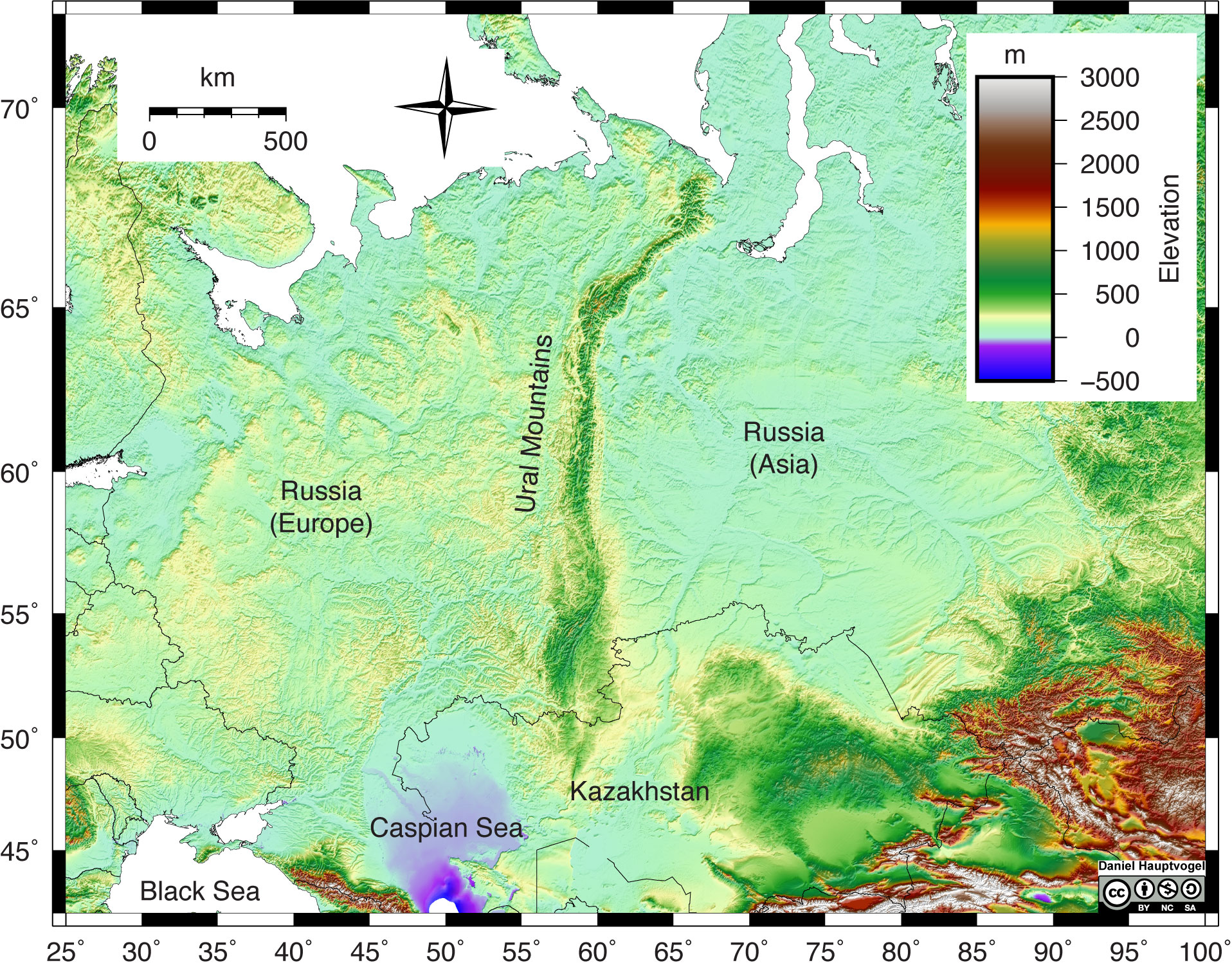
- Over time gobs ranges are weathered and eroded, and the topography slowly goes back to base level. Which get along you think is more likely to be older, a mountain belt with higher elevations or a heaps belt with lower elevations? Explain your reasoning.
- Look at the geography map for part of North US (Figure 1.9). Mark two areas that you think have been finished stellar convergence of tectonic plates.
- Which of the cardinal areas make you think is older? What evidence from the correspondenc supports your hypothesis?
- Look closely at the western portion of the North American continent. You should be able to notice differences in the patterns that make prepared the mountains. Each pattern represents a different geologic region. Draw boundaries along the map that severalize these different geologic regions and then name the patterns you observed to distinguish them (Hint: There are at least three).
- Tectonic plate activity is often associated with mountain building. Supported Australia's topography (Forecast 1.10), explain whether or not you remember the region is tectonically overactive today?
- On the topographic map of Australia (Anatomy 1.10), Deutschmark an area that you think was a plate boundary in the geological past but is atomic number 102 longer active today. Explicate your reasoning for marking this area.
- Critical Thinking: Some of these maps contain areas on continents that are below shipboard level. Come ahead with a hypothesis that explains how this can happen.
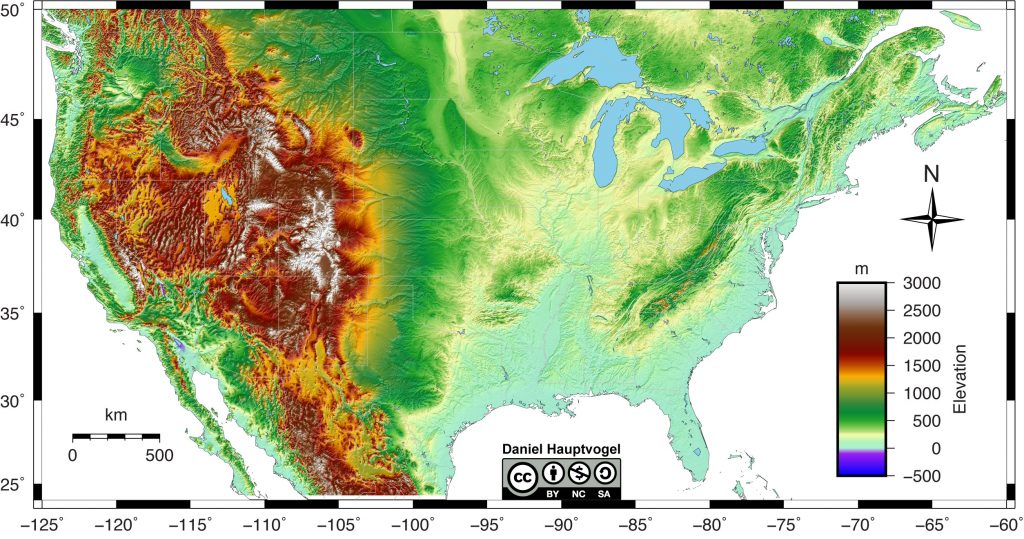
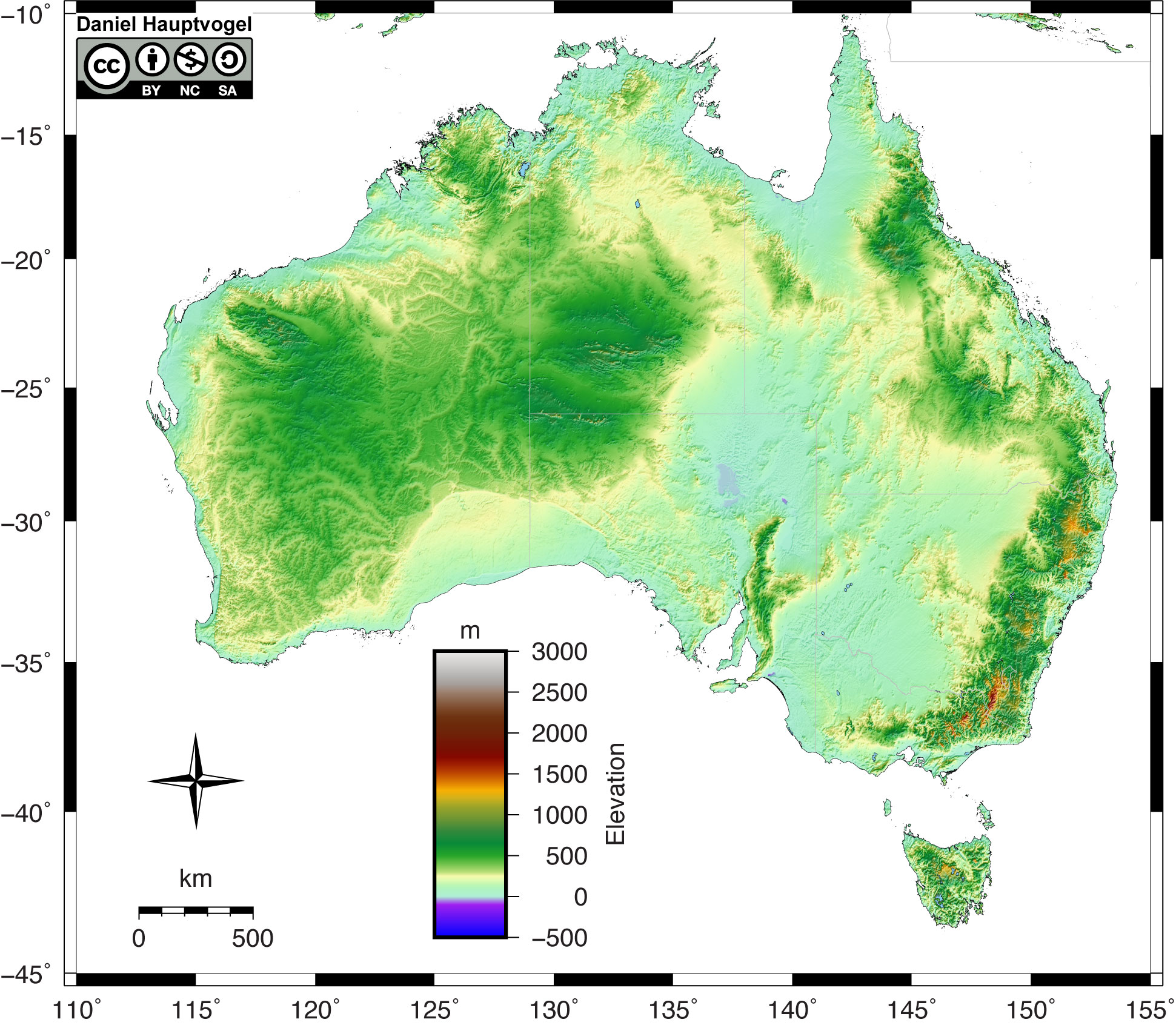
When most masses think about tectonic home plate boundaries, they frequently visualize parallel, symmetric lines separating the plates. This is not always the case in the real world every bit many plateful boundaries are sinusoidal or segmented; this is because Earth is a sphere. Think of this: if you had a ball and tried to wrap it with a flat sheet of composition, would the paper wrap around it perfectly smooth? The answer is no; the paper will want to fold in many places and tear in other places. The morphology plates behave likewise to the paper. Of course, other factors affect the shape of a boundary. Evidence of these plate boundaries is as wel contained in the topography of continents because non completely mountain belts are direct lines.
Below is a geographics map of Texas, Oklahoma, New Mexico, and northeastern Mexico (Figure 1.11). This area is non near an active home tectonic boundary today; the nearest boundary is in the Gulf of Mexico. However, in that location is evidence in this topography to suggest IT was part of a plate tectonic boundary at least double in the geologic past.
- Based on the topography, scratch two areas that make been part of a plate morphology boundary in the earth science past. Topographic changes do not need to constitute isoceles as some tectonic processes are not radially symmetrical.
- I of these boundaries is senior than the other. Label the old and young boundaries.
- One of these boundaries has highs and lows within the smash. What scientific discipline process creates debased topography?
- One of these boundaries splits into cardinal branches. What is the angle betwixt these branches?
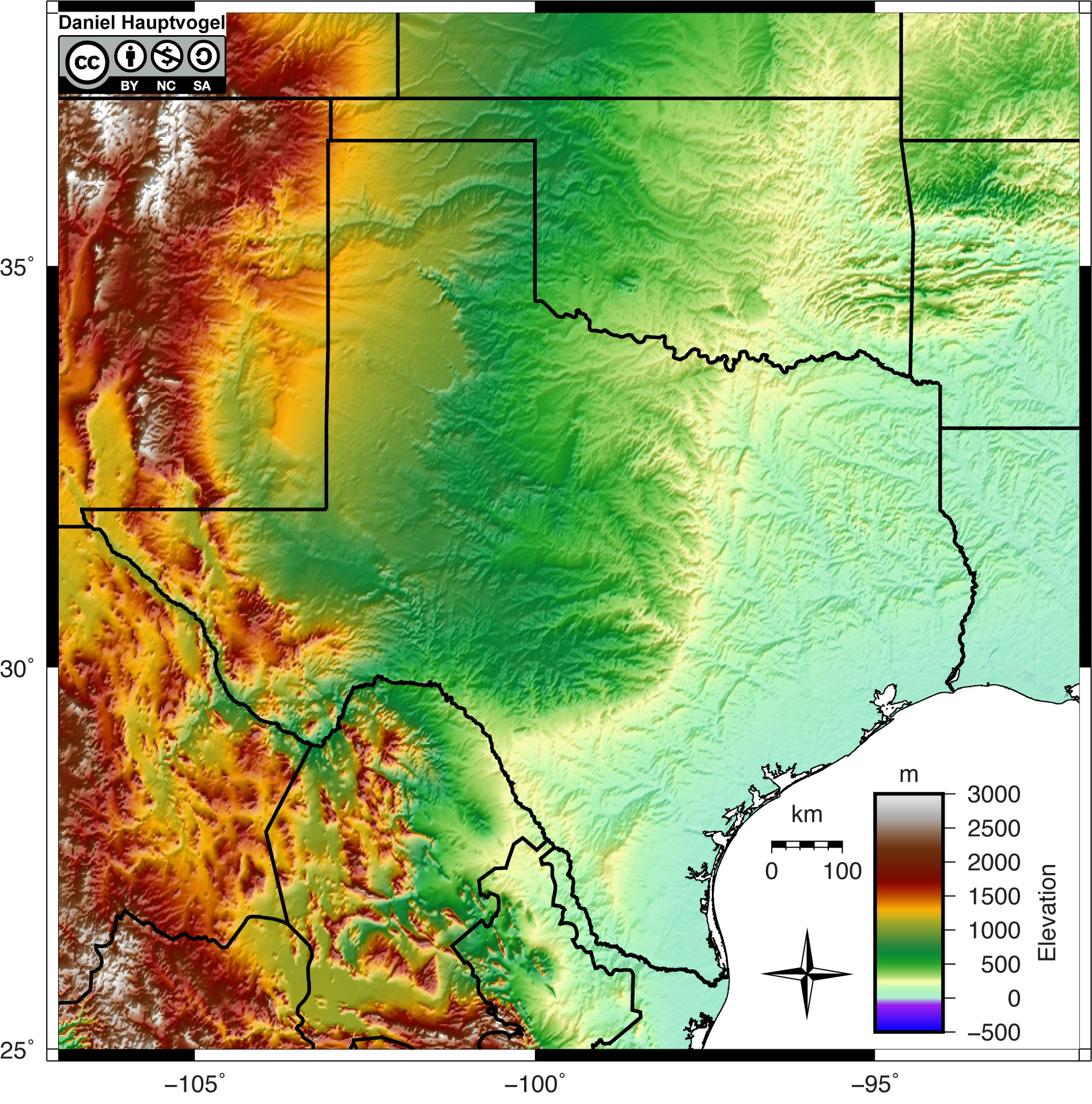
As tectonic plates move, they twit concluded stationary "" of heat from the . Hotspots are still a ill understood geologic phenomenon, but they provide exceedingly hot mantle material to prove close to the surface. Hotspots are marked by volcanoes, which follow from melting of the drape and crust directly above a hot spot. If they pass under oceanic crust, they develop basalts. On the other hand, if they are under continental crust, they shape some basalts and rhyolites, often called bimodal volcanism. Under North America, there are cardinal hotspots: The Yellowstone Rive hot spot, which is currently under Yellowstone Rive Political unit Park in Wyoming and Montana, and the Anahim hotspot in central British Columbia, Canada. Arsenic the Northward American Shell moves over these hotspots, calderas form from mountain activenes; same of the largest volcanic eruptions ever occurred when the Gray's Landing place volcanics erupted 8.72 million years ago preceding the Yellowstone hotspot. One of the controversies is whether the hotspot is still capable of supereruptions or whether the volume of eruptive material is waning.
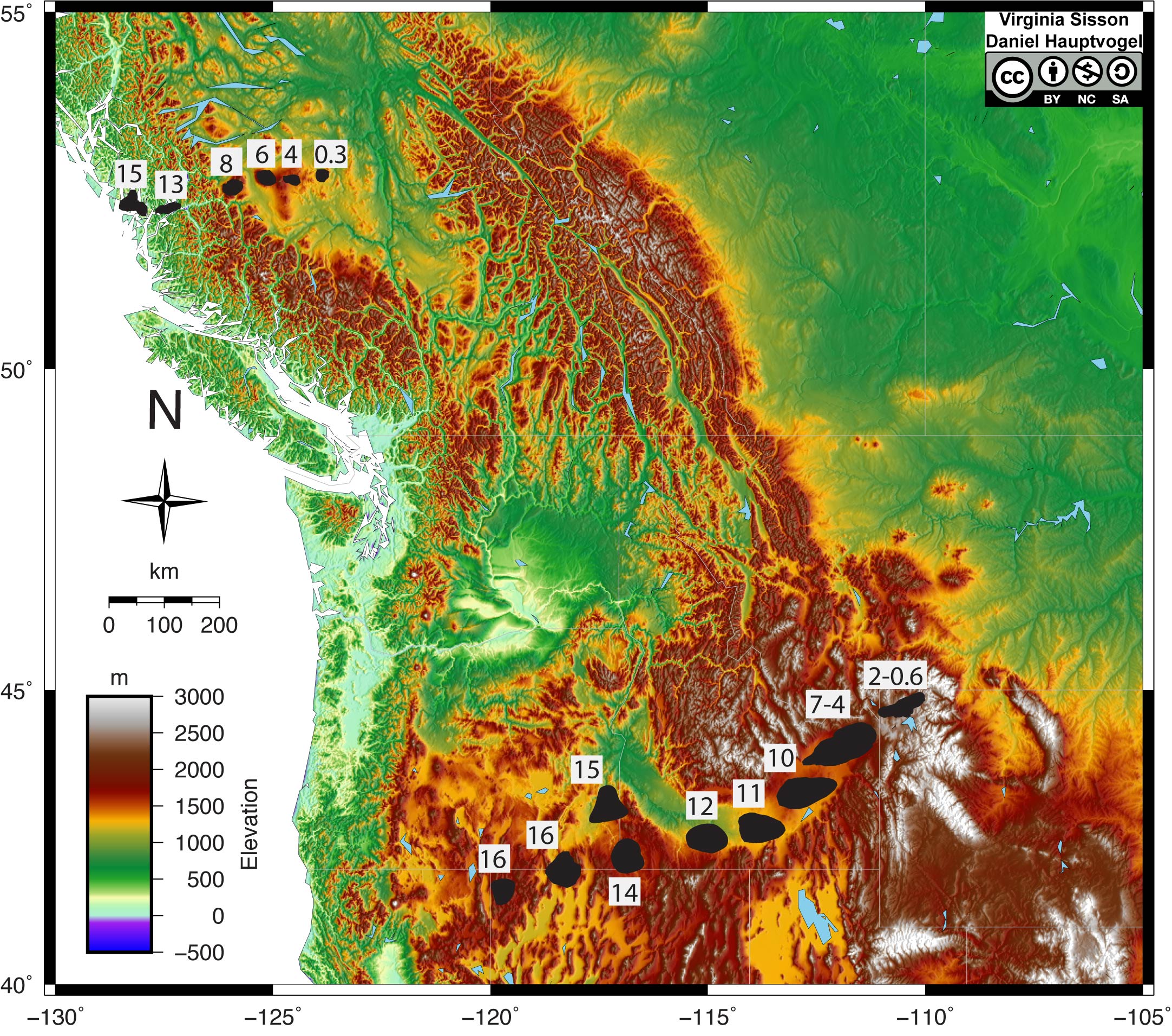
Use up Forecast 1.12 to resolve the following questions about North American hotspots.
- Use a protractor to measure the focal point of the plate move for each hotspot track. This is known as the azimuth and is usually measured dextrorotatory from the north.
- Tilt for Yellowstone: ____________________
- Angle for Anahim: ____________________
- How high-speed is the North American plate moving over these hotspots? Measure the length of the hotspot eruptions from the youngest to oldest. If you split the duration away the maximum age, this will give you the rate of denture motion. Convert this to mm/year (km/my) Eastern Samoa most plate motions are low-velocity rates.
- Rank of plate motion for Yellowstone: ____________________
- Grade of plate motion for Anahim: ____________________
- Are these the Saami for the two hotspots? ____________________
- If not, why are the AZ and the rates contrastive if North America is a rigid home base tectonic block?
The answer may not be obvious as we don't much move things around on a sphere. Alternatively, we remember motion As a straight line from point a to point b. These hotspots are happening the North American plate which way the plate rotates around a point in the eye of boreal Quebec. Since they rotate around a compass point happening a sphere, unusual locations on the photographic plate propel at dissimilar speeds and directions. Geoscientists call this an Euler pole.
- Geoscientists have rhythmical instantaneous global plate motions through versatile techniques such atomic number 3 global positioning satellites (GPS) and very-perennial service line interferometry (VLBI). This data is used to calculate the rates of motion between two plates. There are some online plate motion calculators available; we will function the same created away UNAVCO. Use the parallel of latitude and longitude for the young end of all hot spot and reckon the rate and direction of plate motion. Fill this out in Table 1.6. This web site will give you other info that is not germane to this lab exercise.
Board 1.6 – Answer area for Exercise 1.7c Hotspot Speed (mm/yr) Azimuth Direction Yellowstone Anahim - Sarcastic Thinking: Are the UNAVCO results similar to your calculated results from b? If not, why might you get contrastive answers?
- Has the rank of apparent motion of the North American plate been unvarying along the hot spot track?
- Which hot spot track has more volcanism? Yellowstone or Anahim? Be sure to compare the volcanism over the same period. Consider the size of the calderas when you answer this question.
- Critical Reasoning: Can you explain wherefore one of these has larger unstable eruptions? You may glucinium able to use the topography to supporte you understand each area's tectonic history to help you answer this question.
Exercise Contributions
Daniel Hauptvogel, Virginia Sisson, Michael Assat Andrade, Melissa Hansen
References
Knott, T.R., Branney, M.J., Reichow, M.K., Finn, D.R., Tapster, S., and Coe, R.S., 2020, Discovery of cardinal new super-eruptions from the Yellowstone hotspot track (USA) Is the Yellowstone hot spot waning? Geology, v. 48, p. 934-938. doi.org/10.1130/G47384.1
Martinod, J., Husson, L., Roperch, P., Guillaume, B., and Espurt, N., 2010, Crosswise subduction zones, convergence velocity and the building of the Andes. Terra firma and Planetary Science Letters, v. 299, pp. 299-309. DOI:10.1016/j.epsl.2010.09.010.
Google Earth Locations
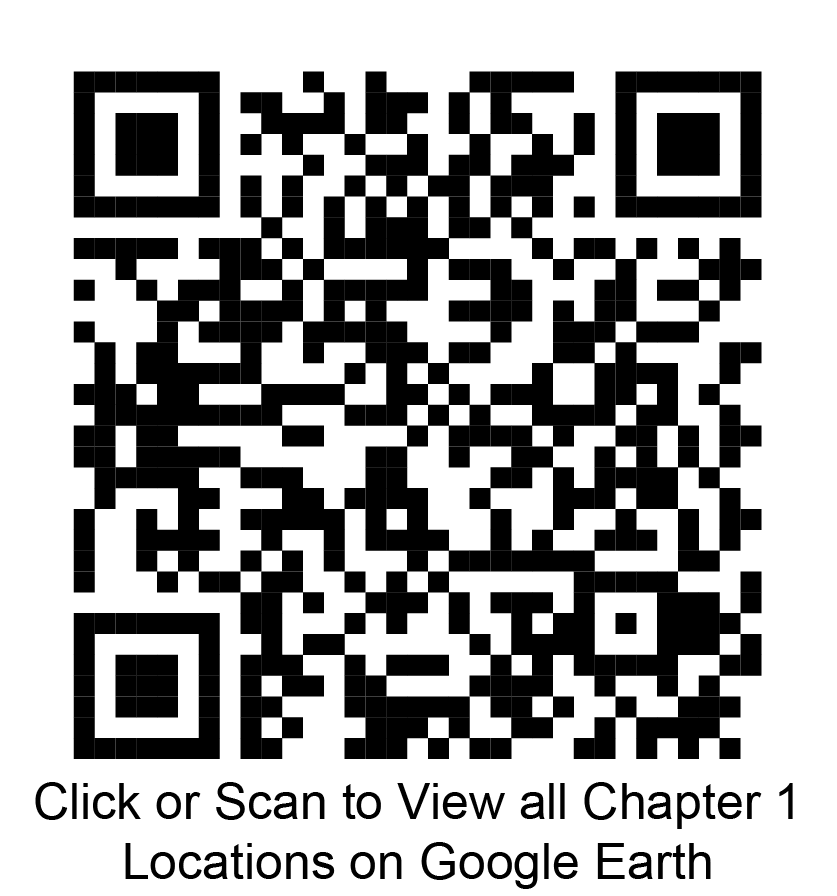
Where Is Subduction Occurring on This Map of South America?
Source: https://uhlibraries.pressbooks.pub/historicalgeologylab/chapter/chapter01-platetectonics/
0 Response to "Where Is Subduction Occurring on This Map of South America?"
Post a Comment